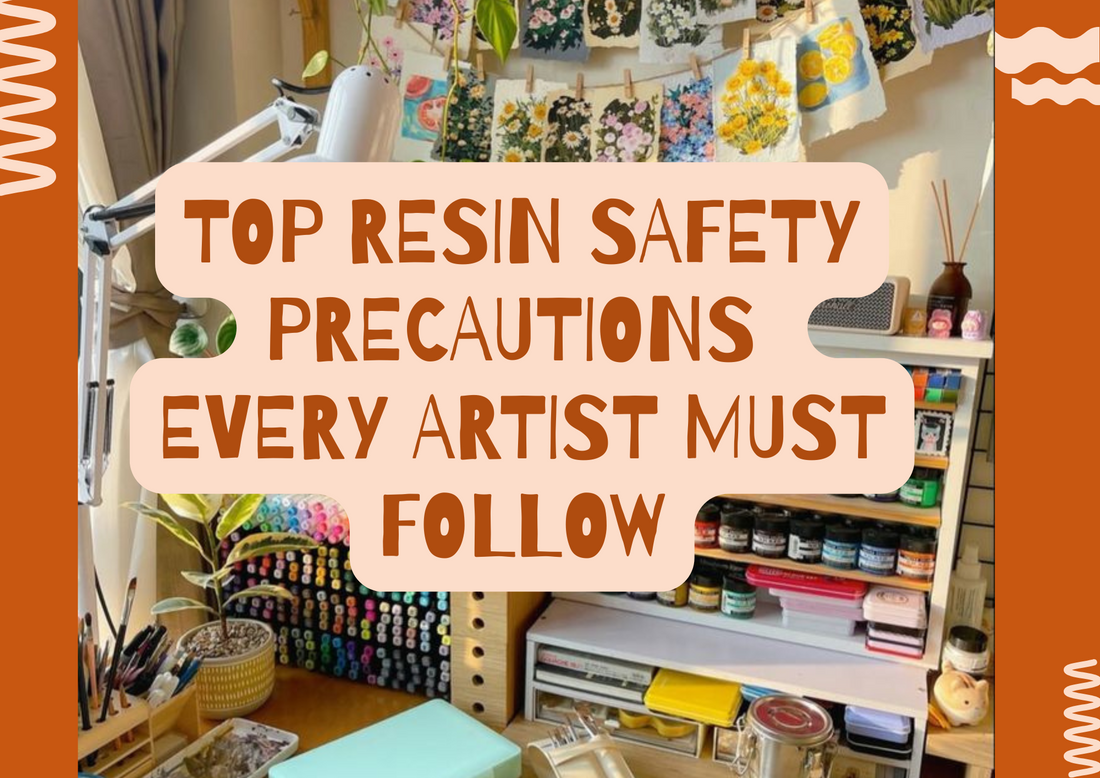
TOP RESIN SAFETY PRECAUTIONS
Share
As is the commonly followed practice among the resin artists, epoxy resin is always used in tandem with the hardener liquid. By following a given ratio, the resin liquid is blended proportionately with the hardener which makes a wide variety of magical creations possible.
But here’s where art meets science.
What feels like a creative ritual is actually a chemical process called polymerization. When the resin and hardener are mixed, their molecules react and start linking together, forming a strong, three-dimensional network., which is simply known as curing in the vocabulary of resin artists.
The reaction releases heat — it’s exothermic — and from mixing to hardening, it’s active chemistry in motion.
The same science that makes epoxy resin sturdy, versatile and artistically valuable, also makes it risky during the curing process.
This makes taking basic safety precautions absolutely uncomprimisable! The resultant heated vapors have the potential to cause allergies or irritation in your nose, throat, lungs and skin.
HERE ARE THE TOP SAFETY PRECAUTIONS THAT EVERY RESIN ARTIST MUST FOLLOW:
1. Work in a Well-Ventilated Area
Why?: Epoxy resin and its hardener release fumes during mixing and curing. Prolonged inhalation can cause adverse health affects like respiratory irritation. Good airflow disperses these fumes. So, work near a window with a fan or use an exhaust setup. For enclosed spaces, a respirator mask is recommended.
2. Always Wear Protective Gear
Gloves: Prevent skin irritation and allergic reactions from resin contact.
Safety Goggles: Shield your eyes from accidental splashes.
Respirator Mask or even, a simple cloth mask: Filters harmful fumes, especially when sanding cured resin.
Why?: Protective gear ensures a barrier between you and the chemicals, ensuring safety from any side-effects.
3. Avoid Direct Skin Contact
Why?: Even brief exposure may cause redness, rashes, or burns. Once an allergy develops, it usually worsens with each exposure.
Tip: Keep wet wipes handy to cleanse off resin when it comes in direct skin contact in the on-going process. Use soap and water at the end.
4. Store Resin Properly
Why?: Resin and hardener are sensitive to temperature and moisture. Storing them in airtight containers at a stable room temperature prevents premature curing or contamination.
Do’s:
Keep between 15–24°C.
Store in the original, tightly sealed containers.
Avoid direct sunlight and never refrigerate.
5. Mix Carefully and Accurately
Why?: Incorrect ratios of resin to hardener can leave sticky, toxic, or improperly cured projects. Over-stirring can trap bubbles, while careless handling can splash resin around.
Tip: Always measure with clean tools and mix slowly for best results.
6. Never Eat, Drink, or Smoke While Working
Why?: Resin particles can settle on food, leading to accidental ingestion. Being an inedible chemical, it may cause serious isde-effects.
7. Protect Your Work Surface
Why?: Resin is permanent once cured. Using a silicone mat, plastic sheet, or wax paper prevents damage to tables and makes cleanup easier.
8. Handle Curing Resin with Caution
Why?: During curing, resin heats up due to a chemical reaction (exothermic reaction). In large volumes, this can cause burns, cracks, or even fire hazards.
Tip: Pour in thin layers and avoid leaving mixed resin sitting in cups for long.

With Oytra, you can start your creative side hustle today!
To replenish your art supplies, visit Oytra’s official website or find our products on Amazon
For instant doorstep delivery for your last-minute project needs, you can also get Oytra’s products on Blinkit!
Surf through our blogs and our YouTube Channel for detailed guides, product recommendations, and tips to make the most out of your resin endeavours.

12 comments
n1001p
49sb1k
8lgcoo
8lgcoo
4to0sq